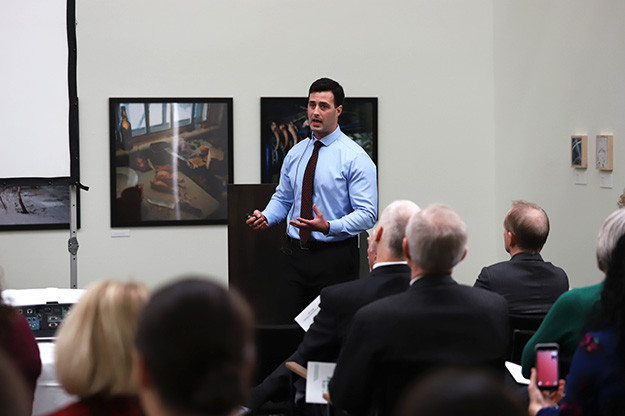And fitness for all
John Fitzgerald’s ‘Faster, Higher, Stronger’ research for athletes carries message of better health and longer life for everyone

UND kinesiologist John Fitzgerald lives life in the fast lane.
Outside the classroom, he’s an outdoorsman who puts his snowmobile to the test in the winter and skims the wakes of Minnesota’s lakes by boat in the summer, according to colleague and mentor, Professor Grant Tomkinson.
“Simply put, John Fitzgerald is a rock star,” Tomkinson told about 50 people gathered to hear Fitzgerald talk about the crossroads of high-performance athletics with everyday health and fitness for all. “All the other things about him you can learn from his bio, but if you talk to him, you’ll quickly understand that John loves speed.”
Fitzgerald’s presentation was the latest in the 2017-18 UND Faculty Lecture Series, and true to his active lifestyle, he kept the discussion quick and lively as he connected the dots on how and why many of the same attributes enjoyed by hard-training world-class athletes also translate to better health for Joe and Jane Public.
A native of Crookston, Minn., Fitzgerald is an assistant professor of kinesiology and public health education, part of the UND College of Education & Human Development. He received his Ph.D. from the University of Minnesota, and his research interests include the physiological factors influencing health and physical performances of athletes.
Fitzgerald has conducted research with NCAA athletes across the United States, as well as with elite ice hockey players around the globe.
Mortality predictor
For his lecture, Fitzgerald focused on aerobic fitness, muscular fitness, and body composition – the most important types of fitness for sports performance and good health.
While researching at UM, Fitzgerald analyzed 50 NCAA Division I and other elite-level hockey players in the Twin Cities area on their ability to perform repeated bouts of on-ice skating, similar to a typical shift during a game (40 seconds on average). The quick, darting bursts used by hockey players during these relatively short shifts are largely a product of their anaerobic (short duration) metabolism.
The big question for Fitzgerald was whether improved aerobic conditioning (activities that increased the capacity of the heart, lungs and muscles over much longer periods) played a role in helping these athletes recover more quickly after anaerobic fatigue. Results showed that better aerobic fitness led to less fatigue during repeated shifts and it was recommended that both aerobic and anaerobic training be incorporated into ice hockey strength and conditioning training.
But Fitzgerald’s findings on good all-around aerobic fitness aren’t limited to elite hockey players. His work transcends the rink and is reflected in society as well. One of the strongest predictors of early death is aerobic fitness – more than obesity, smoking and living with diabetes — when you factor in the number of people with the risk factor, he said.
Research shows that improved aerobic fitness can significantly reduce your chances of developing or dying from chronic conditions such as heart disease, stroke and some cancers.
And the habits, good or bad, start early. Fitzgerald connected his discussion to global research youth fitness by Tomkinson that shows good aerobic fitness in adolescence is significantly linked to longevity.
Power to the people
When it comes to muscular fitness, Fitzgerald contends that traditional strength training may be overrated.
He puts more weight, so to speak, on training for power, the ability to quickly generate force.
“It’s the rate of force development (power) more than strength that allows athletes to run past their opponents,” Fitzgerald said.
In everyday life and as people age, Fitzgerald says that improved and sustained muscular development, including increases in power, leads to greater independence and higher quality of life. It also means fewer falls.
Fitzgerald said people tend to lose power faster than they lose strength. These declines are linked with poorer performance in activities of daily living and also can be a predictor of untimely death due to diminishing balance and increased occurrences of falls.
Jumping mechanography techniques, an area of specialty for Fitzgerald, is one way professionals are improving strength, power and balance in elderly populations.
Keep it simple
Fitzgerald also touched on body composition, which can vary greatly for athletes depending on their specialty. The slight frame of a marathon runner is much different than the massive physique of a track and field weight thrower or the compact muscularity of a gymnast.

For most of us, however, body composition focuses on the size of our waistlines and how that helps or hinders our overall health and fitness.
Fitzgerald said that body mass index (BMI) is a good indicator of body fatness and obesity, which is high in the United States. Increased chances of hypertension, dyslipidemia, Type 2 diabetes and cardiovascular diseases are closely tied to obesity. Also, obese people typically pay about $1,500 more in medical costs each year.
To reverse this trend, Fitzgerald recommends a combined approach of diet and exercise to effectively lose weight.
He suggested trying enjoyable activities, such as walking, jogging, biking, tennis, swimming or even gardening, and increasing frequency, duration and intensity over time.
But don’t forget about muscular development. Simple weight and resistant-band exercises go a long way in improving health and fitness.
Tomkinson emphasized Fitzgerald’s simple message not to overcomplicate matters.
“You don’t need to buy sophisticated equipment to be physically active,” Tomkinson said. “All you need is to put some elbow grease back into your life and just keeping moving.”
Next lecture
The final Faculty Lecture of the 2017-18 season is set for April 25, when UND Electrical Engineer Sima Noghanian is set to present.
Faculty Lecturers are selected by a team of Chester Fritz Distinguished Professors, and the lectures are sponsored by the Offices of the President and Provost.


